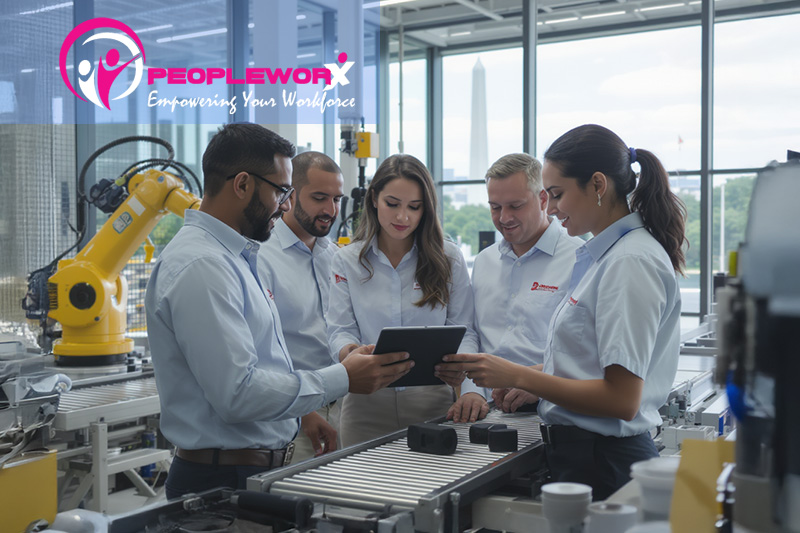Retail HRIS adoption often becomes essential long before leaders expect it. Success with one or two stores and a small team can quickly outgrow spreadsheets, email approvals, and paper files, causing errors, bottlenecks, and compliance risks. That’s when upgrading to a modern HRIS shifts from “nice to have” to a business necessity.
This is the story of a family-run retailer that reached that tipping point, and how PeopleWorX helped turn HR challenges into clarity and scalable growth.
Content
- Retail HRIS vs. Manual HR: What Growing Businesses Learn
- Recognizing the Need for a Retail HRIS
- Retail HRIS Explained: Why It’s Essential for Retail Success
- How We Helped This Retailer Choose the Right HRIS
- Implementation Phases: How the Rollout Worked
- Driving Adoption: Training + Change Management
- The Results: Efficiency, Accuracy & Growth
- What’s Next on the Retail HR Journey
Retail HRIS vs. Manual HR: What Growing Businesses Learn
Our retailer started with heart and grit: one storefront selling artisanal home goods, led by family members who handled everything from hiring to scheduling. As demand grew, they opened a second and then third location. But behind the excitement lurked mounting HR headaches:
- Each location used its own process for time-off approvals: email, sticky notes, verbal requests
- Payroll was processed via basic accounting software, leading to miscalculations and missed deductions
- Document storage was decentralized, mostly paper files in cabinets
- New hires experienced inconsistent onboarding depending on which store they joined
As the business pushed toward 40 employees across three sites, these cracks widened. Managers spent hours reconciling spreadsheets. Payroll errors frustrated staff. The founders found themselves pulled into HR minutiae rather than strategic decisions.

Recognizing the Need for a Retail HRIS
For many small businesses, manual processes can stretch further than they should. But after their compliance audit exposed documentation gaps, timekeeping discrepancies, and outdated labor policies, this retailer realized they needed a better way forward.
The leadership team turned to peers and their accountant for advice. The consistent recommendation: invest in a retail HRIS to centralize HR data, automate payroll, and strengthen compliance.
A retail HRIS isn’t just software, it’s a foundation for scalable workforce management. By consolidating records, digitizing onboarding, tracking time consistently across locations, and ensuring payroll accuracy, HR leaders gain the visibility and control they need to grow. For retailers balancing multiple stores and dozens of employees, an HRIS moves HR from reactive problem-solving to proactive people management.
Retail HRIS Explained: Why It’s Essential for Retail Success
An HRIS is a unified software platform that centralizes HR tasks, data, and workflows. For a growing retailer, it offers the infrastructure to:
- Maintain secure, centralized employee records
- Automate payroll and tax compliance, eliminating manual errors
- Integrate time and attendance tracking, even syncing with POS/time clock systems
- Digitize onboarding and offboarding processes
- Manage benefits enrollment and administration
- Enable employee self-service portals
- Generate compliance-ready reports and analytics
In short: an HRIS turns reactive HR into strategic people management.
How We Helped This Retailer Choose the Right HRIS
After reviewing several systems, this retailer selected PeopleWorX due to our specialization in small to medium businesses and commitment to expert-led support. Our approach began with a detailed assessment of their workflows, compliance gaps, and growth trajectory.
What we proposed:
- A unified employee database accessible from any location
- Automated payroll with built-in tax and regulatory compliance
- Time & attendance module that synced with existing POS/clock systems
- Employee self-service features for everyday tasks
- Custom reporting and dashboards to monitor HR KPIs
Because we don’t just provide software, we partner with clients to deliver outcomes, our team mapped out a rollout plan designed to minimize disruption.
Implementation Phases: How the Rollout Worked
We executed a phased rollout:
Phase 1 — Core Modules (Payroll, Time, Onboarding)
- Migrated existing employee data into PeopleWorX
- Activated payroll automation
- Switched timekeeping to integrated digital clocks and portals
- Digitally replaced paper onboarding and document workflows
Phase 2 — Advanced Modules (Self-Service, Benefits, Reporting)
- Enabled self-service tools for employees to access pay stubs, request time off, and update personal data
- Launched benefits administration features
- Rolled out advanced reporting for HR leadership
Within just two payroll cycles, over 95% of employees were actively using the system. Administrative hours fell, and accuracy rose.

Driving Adoption: Training + Change Management
Technology doesn’t succeed by itself, people make it real. We combined structured training and communication to drive adoption:
- Live webinars and step-by-step video tutorials
- Store-level HRIS champions trained to support peers
- On-demand access to PeopleWorX HR experts for real-time issue resolution
- Encouragement for employees to explore self-service features on their own
By focusing on empathy and clarity (not jargon), we helped employees feel confident rather than intimidated. The result: fewer support tickets and faster uptake.
The Results: Efficiency, Accuracy & Growth
Post-implementation, this retailer saw immediate improvements:
- Dramatic drop in payroll discrepancies
- Consolidated, auditable employee records
- Less time spent chasing approvals or reconciling spreadsheets
- Higher employee satisfaction through self-service tools
- Stronger compliance posture and readiness for audits
Most importantly, leadership gained time and clarity to focus on growing the business, not resolving HR emergencies.

What’s Next on the Retail HR Journey
With the HRIS solidly in place, the retailer is now turning their attention to advanced capabilities:
- Performance management and review workflows
- A more streamlined applicant tracking system
- Workforce analytics and predictive staffing tools
They don’t see growth as a risk, they see it as an opportunity. And now they have technology and people strategy aligned.
This transformation, from spreadsheets to scalability, shows the real impact of adopting a retail HRIS at the right moment. By replacing manual processes with a centralized system, businesses can reduce errors, strengthen compliance, and free leaders to focus on growth. At PeopleWorX, our mission is to partner with growth-minded retailers and organizations, helping them unlock productivity, compliance, and people potential through smarter HR solutions.






